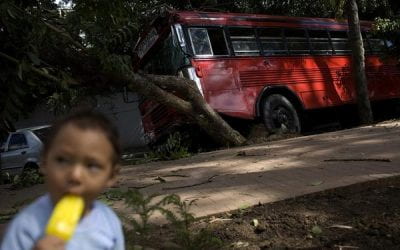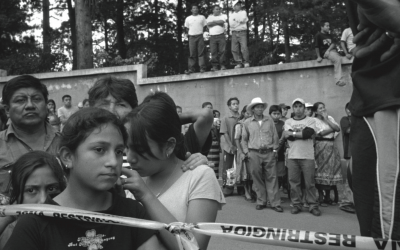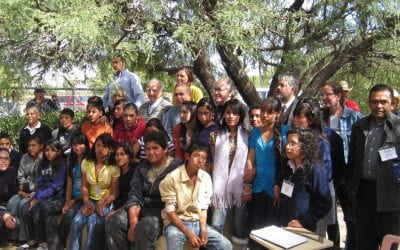The Fight Against Drug Trafficking and Crime in the Americas
Stunted Regional Cooperation and Failing U.S. Partnership
If you live somewhere in Latin America, chances are that what you worry about is not your paycheck or the near-constant corruption scandals, but that you or family members may be robbed, kidnapped or attacked on the street. Each month tens of thousands of Latin Americans suffer criminal attacks, often by organized gangs, and have no effective recourse from incompetent or corrupt local police and courts. In the worst cases, such as in Guatemala and El Salvador, residents sometimes respond by arranging revenge killings themselves, which can cost as little as a hundred U.S. dollars. Wealthier citizens pay much more for 24-hour private security and armored cars and even protective clothing.
Organized crime is a threat both internal and external. Most large criminal organizations are rooted locally. Their success at smuggling, extortion, kidnapping, and other crimes requires extensive local knowledge and reliable networks of families and partners. As they grow, however, they find it more efficient and profitable to move beyond just trafficking and branch out into the buying and processing of cocaine and other drugs, and then to goods beyond drugs. Colombia’s drug cartels dominated regional production and trafficking through the 1990s. More recently, Mexican cartels have expanded their operations southward into Central America and beyond. Operations of the Mexican Sinaloa and the Zetas cartels have been uncovered from the United States to Brazil and Argentina. As these organizations expand, they link up with criminal organizations from the United States, Russia, the Middle East and China, and occasionally even with terrorist organizations including Colombia’s FARC and Middle Eastern Hezbollah.
International security cooperation in the Americas has traditionally been crippled by conflicting security interests and visions, and the lack of a region-wide threat. Historically, such cooperation has flourished only when external threats forced an alignment among most governments of the region and the United States, as for example during the Second World War and the Cold War following the Cuban revolution. Most hemispheric institutions such as the Organization of American States (OAS), the Summit of the Americas process, or the recently formed South American Union (UNASUR), promote economic relations and democratic norms rather than cooperative security. Rhetoric about shared interests in building peace rarely leads to binding agreements or meaningful cooperation. Tensions over borders and ideological differences undermine trust and transparency. As a result, despite numerous attempts to build a hemispheric or Latin American framework for security dialogue, confidence building, and cooperation, in practice regional security consists mostly of episodes of crisis response, most often led by the United States.
In the 1990s, most Latin Americans felt little effects from drugs or drug trafficking. These were U.S. problems, caused by U.S. consumption. However, as narcotrafficking become the source of funding for violent insurgents and paramilitaries in Colombia and Peru, and as drug use and drug-related gang activity has exploded around the region, that view grew untenable. Organized crime affects daily life. Today, the central questions are whether the drug traffickers and organized crime should be fought with militaries or with weak police forces, or even whether current governments are capable of fighting them at all.
Though most governments agree that organized crime and drug trafficking pose critical threats to regional security, they disagree on how to respond. They disagree even on the identity of these actors. In Colombia, Peru, Mexico, Chile and most countries of Central America criminal gangs are perceived as serious threats to the state. On the other hand, left-wing governments in Venezuela, Ecuador, and Brazil have been reluctant to take a firm position. This is due to ideological affinity within these governments with insurgents like the FARC, who are involved in narcotrafficking, and because these governments generally oppose the cooperation with the United States that is central to anti-drug efforts. Again, regional security relations are fragmented. Governments which perceive drug trafficking and organized crime as security crises have turned to the United States for support, while others denounce U.S. cooperation as imperialism.
Since Mexico in 2006 joined Colombia in waging a full-out war against local drug cartels—both with significant support from the United States—the costs of the lack of regional cooperation have become painfully apparent. Colombia’s success at pressuring the drug industry in its territory pushed it into Mexico. Now Mexico’s campaign has pushed the industry into Central America, Venezuela, Guyana, and Brazil. Ever more cocaine and other drugs are being shipped to Brazil, now the world’s second largest drug consumer, or across the Atlantic to West Africa and Europe.
This is not to say that regional cooperation against crime is nonexistent. Institutions for security cooperation at the regional level (e.g., among Caribbean island states, Central American countries, or the Southern Cone) have made some progress. The Caribbean community is relatively effective at sharing police information and working with the United States, Canada, and European partners on security issues. The Andean community, likewise, has tried to formulate policies and reach agreements on security matters, though these efforts have been undercut by contention over Colombia’s counterinsurgency campaign and the meddling by Hugo Chávez in his neighbors’ political affairs. Central America has two institutions for regional security cooperation, its System for Integration (SICA) and its Armed Forces Council (CFAC). However, these efforts are undermined by conflicts of interest among member states, by the lack of importance member state governments give to SICA and CFAC initiatives, and by the lack of integration between civilian governments and their armed forces. UNASUR has created a South American Anti-Drug Council, though to date this council exists mostly on paper.
More progress has been made via bilateral coordination between mutually interested partners. Several pairs of countries have begun to coordinate their border control efforts and to share intelligence on activities and operations in their border zones. For example, Colombia, Peru, and Brazil cooperate to monitor their Amazonian borders; Colombia also cooperates with Ecuador and Panama; Guatemala and Mexico cooperate; and Brazil and Bolivia do so even via the use of Brazilian unmanned surveillance drones. These efforts are relatively successful, in part because in being bilateral they avoid political grandstanding over broader strategic disagreements, and because they are conducted by military, police, and intelligence divisions who can focus effectively on operational and technical issues.
Brazil’s efforts are notable, because it seldom dedicates significant attention to affairs in its hinterlands. Recently, though, its drug and crime epidemic and especially the power and ruthlessness of its drug gangs in the favelas of Rio de Janeiro, São Paulo, and other cities have become issues of national frustration and public action. Like the United States before it, this regional power has discovered the importance of trying to stop the entry of drugs at its borders, and the utility of helping its neighbors improve their own law enforcement capabilities. Predictably, however, these initiatives have opened complicated new dimensions in Brazil’s relations with its smaller, poorer neighbors.
Americans know all about complex, mutually frustrating neighborly relations. Along with the European Union, the United States today is eager to help the Central American republics improve their capacities and link their efforts to those of Mexico and Colombia. At a July 2011 regional meeting, Secretary of State Hillary Clinton pledged over $300 million in assistance for Central America. The EU, the Inter-American Development Bank, and the World Bank also pledged hundreds of millions more.
Washington would like to do so via SICA, in order to create and support shared regional policies. The U.S. government is not yet convinced, however, that its partners in the region are truly committed to, or capable of, implementing the reforms necessary to improve security under the rule of law. Despite a slew of reform programs and hundreds of millions of dollars in security assistance over the last decade, the countries of Central America still lack professional, well-equipped, reliably effective police and security forces.
Conversely, Guatemalans and Salvadorans have good reason to question the future of U.S. commitment. The United States is cutting its assistance to Colombia, even though its closest partner is still at war against the FARC and a host of violent narcotrafficking groups. Exhausted by fruitless wars in Iraq and Afghanistan, Washington has little stomach for supporting Colombia-style security campaigns across Mexico and the whole of Central America, costing billions per year. Unlike Colombians, Mexicans have not widely supported U.S. cooperation in their struggle. Indeed, many Latin Americans blame the United States for the disastrous strategy of militarizing the war against drug producers and traffickers, a strategy that has done nothing to stanch the northward flow of cocaine but has cost the region hundreds of thousands of lives and huge economic damage.
Worse, Latin Americans and increasingly U.S. citizens too perceive that there is no end-game to this strategy. The best the U.S. government can hope for is to continue to push drug trafficking routes, and the crime and violence they create, from one region to another every decade or so: from Central America, perhaps to Venezuela, Guyana, and Suriname; perhaps through the Amazon, or via submarines in the Pacific. This is not a strategy Latin Americans can accept. And as U.S. attention to and influence in the region wane, they will increasingly seek other options for better or worse, such as the legalization of drug trafficking.
Spring 2012, Volume XI, Number 3
Ralph Espach is an analyst and director of the Latin American Affairs program at CNA’s Center for Strategic Studies, in Alexandria, Virginia. He has authored and co-authored several books, including Private Environmental Regimes in Developing Countries, Latin America in the New International System, Combating Corruption in Latin America, and Security in the Caribbean Basin.
Related Articles
Latin American Organized Crime’s New Business Model
Human heads rolling in the street alongside affluent homes. Gory stories of mass graves unearthed in Tamaulipas and Durango. Kidnapping and ransoming of migrants. Paying…
Lessons from Colombia for Mexico?
One of the things that struck me most on my last trips to Colombia in January and June 2011 was the great level of optimism regarding the country’s security accomplishments after several…
Making a Difference: Grassroots Educational Change in Mexican Public Schools
Middle-school teacher Miguel Hernández, from the state of Querétaro in Mexico, is learning math. Surprisingly, his teacher is Blanca de la Cruz, a ninth-grade student from a small rural…





